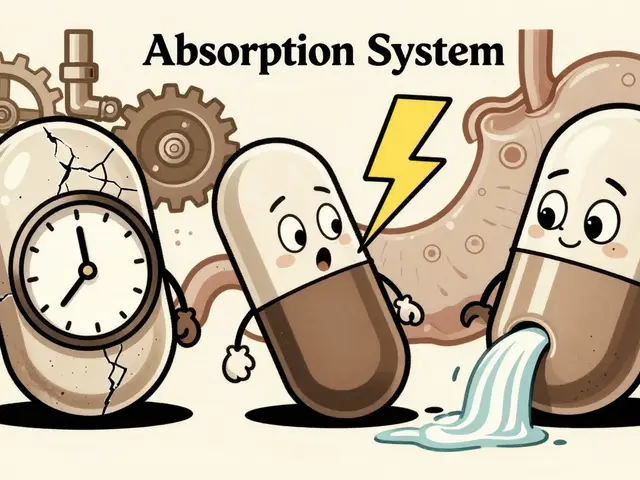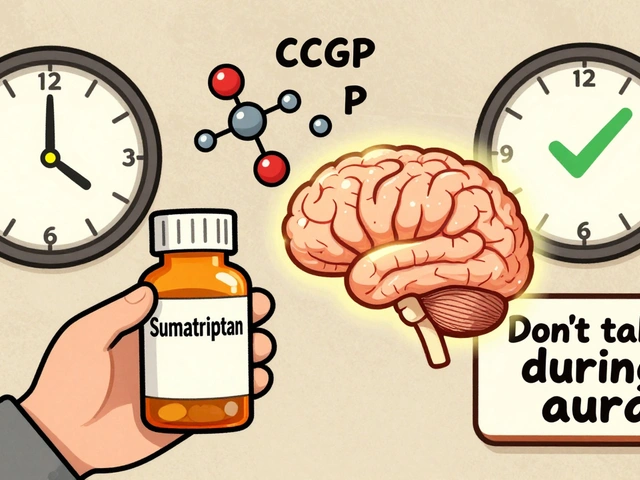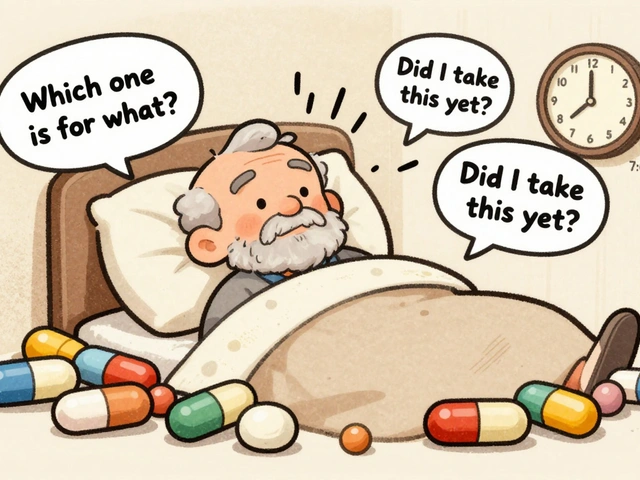Parkinson's disease presents various challenges, and fatigue is among the most pervasive yet underestimated symptoms. It leaves individuals feeling persistently tired, impacting their quality of life significantly. Managing this fatigue is crucial, and this is where carbidopa-levodopa-entacapone plays a pivotal role.
This blend of medications is designed to strike a balance by delivering dopamine efficiently to the brain, alleviating both motor and non-motor symptoms of Parkinson's. Each component synergizes to combat fatigue, while also offering potential side benefits for those with the condition.
In this article, we'll explore the blend's mechanism, understand its benefits along with potential side effects, and share practical advice for Parkinson's patients aiming to utilize this treatment effectively in their day-to-day lives.
- Understanding Parkinson's-Related Fatigue
- Mechanism of Carbidopa-Levodopa-Entacapone
- Benefits and Side Effects
- Practical Tips for Patients
Understanding Parkinson's-Related Fatigue
Fatigue in Parkinson's is not the kind of tiredness that goes away with a nap or a good night’s sleep. It's a deep, pervasive exhaustion that seems to seep into every aspect of life, affecting both physical and mental capacities. It often stands among the most demanding symptoms to manage, with patients frequently describing it as a feeling of having their energy sapped away without warning. This unpredictable nature makes it particularly challenging in day-to-day activities, where consistent energy levels are crucial.
Many factors contribute to this type of fatigue. Parkinson's disease itself involves degeneration of dopaminergic neurons in the brain, which not only influences motor skills but also impacts mood and energy regulation. The lack of dopamine can lead to increased energy demands, as simple tasks become exhausting to complete. Another significant contributor is depression, which is common in Parkinson’s patients, exacerbating feelings of weariness as it takes a toll on mental stamina. Similarly, medications like carbidopa-levodopa that regulate motor function can sometimes cause fatigue, creating a challenging balance for clinicians and patients alike.
According to a recent survey by the Parkinson's Foundation, about 50% of participants reported fatigue as one of their most pressing concerns. Sleep disturbances are also common, which magnify the problem. Many individuals with Parkinson's experience disrupted sleep due to muscle cramps, frequent urination, or nightmares, further contributing to daytime fatigue. Quality sleep often remains elusive, creating a vicious cycle that is tough to break. The interconnection between sleep and fatigue highlights the multifaceted nature of managing Parkinson's and the need for comprehensive treatment approaches.
Parkinson's-related fatigue differs greatly from typical tiredness, requiring targeted interventions. Energy conservation techniques, cognitive behavioral therapies, and lifestyle modifications often become part of a strategic approach to manage this overwhelming tiredness. Emphasizing the limitations of current treatments, it becomes evident why patients are keen to explore medication like carbidopa-levodopa-entacapone, hoping to alleviate some burden of fatigue while addressing motor symptoms. A study published in the Journal of Neurology highlights that those using comprehensive approaches report better quality of life outcomes.
"Fatigue is a silent thief that steals my days without warning. Managing it effectively involves understanding all its contributory factors," shared renowned neurologist Dr. Ellington Peters. Such insights are valuable for framing treatment plans that address the multifaceted contributors to fatigue.
In essence, understanding and managing Parkinson's-related fatigue is paramount for enhancing life quality. The interplay between physical symptoms, emotional health, and treatment side effects must be constantly evaluated to find relief. Collaborative efforts between patients and healthcare providers are essential, aiming for strategies that are as dynamic as the symptoms they seek to address. This partnership often holds the key to uncovering personalized solutions for managing fatigue in Parkinson's disease.

Mechanism of Carbidopa-Levodopa-Entacapone
Understanding how carbidopa, levodopa, and entacapone work together starts with acknowledging their roles individually. Levodopa is the precursor to dopamine, a crucial neurotransmitter deficient in people with Parkinson's disease. By itself, levodopa would rapidly convert to dopamine outside the brain, reducing its efficacy. Enter carbidopa, which acts as a guardian, preventing this premature conversion so that more levodopa reaches the brain. This process maximizes the benefits of levodopa, leading to better symptom management.
The story doesn’t end there, though. The metabolism of dopamine is another hurdle. Once dopamine is produced in the brain, it is quickly broken down by an enzyme called catechol-O-methyltransferase (COMT). Here, entacapone steps in as an effective COMT inhibitor, slowing the breakdown process. With these components working in harmony, the medications not only replenish dopamine more efficiently but also sustain its presence in the brain for longer durations. Through this synergy, patients experience extended relief from both motor and non-motor symptoms including fatigue.
A clinical study underscored the importance of combination therapy in Parkinson's management. This study revealed that patients taking carbidopa-levodopa-entacapone reported fewer 'off' periods where symptoms returned, enhancing their quality of life significantly. It’s a compelling testament to the therapy’s prowess in maintaining consistency in dopamine delivery. The connection between dopamine levels and fatigue relief highlights why this combination is so crucial for Parkinson's patients.
"The integration of these three medications provides a comprehensive approach to dopamine management, which is the cornerstone of modern Parkinson's therapy." — Dr. A. Parker, Neurologist and Parkinson's Specialist
Aside from the laboratory dynamics, understanding the patient's daily routine adjustments is vital. Dose timing, for instance, becomes crucial as it impacts therapeutic outcomes. Many patients benefit from taking the medication an hour before meals to optimize absorption and efficacy. This careful coordination underscores the importance of patient education in conjunction with medical prescription.
While navigating treatment, one cannot overlook the potential side effects. Some patients report experiences like daytime drowsiness or mild nausea. Awareness and communication with healthcare providers help navigate these effects, ultimately ensuring that therapies are tailored to individual needs. The goal is a personalized treatment plan that optimizes efficacy and minimizes any downsides. This complex interplay of pharmacology and personalized care underscores the innovative nature of this approach in managing Parkinson's disease.

Benefits and Side Effects
Carbidopa-levodopa-entacapone stands out as a significant treatment for managing not just the motor symptoms, but also the fatigue associated with Parkinson's. Its prime benefit lies in its formula, which amplifies the benefits of dopamine replacement therapy. Many patients report a notable reduction in fatigue, which helps extend their daily functionality. Carbidopa assists by ensuring that more levodopa reaches the brain before being converted peripherally, which translates to more effective symptom control. Levodopa itself is key to replenishing dopamine levels, while entacapone inhibits an enzyme called COMT that breaks down dopamine, providing a longer window of relief. The blend can be an excellent choice for those not responding adequately to previous regimes.
Despite its many advantages, it’s crucial to be aware of the potential side effects. The combination can sometimes cause dizziness, nausea, and even a sudden drop in blood pressure when standing, known as orthostatic hypotension. These effects should be monitored, especially in the initial stages of the treatment. In rare cases, patients have experienced disturbances in sleep and may notice changes in their impulse control. Some users have pointed out an increase in vivid dreams or nightmares. Always communicate with your healthcare provider to address these side effects early on. Interestingly, a study in 2022 revealed that about 65% of patients felt an enhanced sense of energy after adjusting the dosage under medical supervision, highlighting the importance of personalized treatment.
A
"A balanced approach to Parkinson’s care always includes managing fatigue, crucial for sustaining life quality," notes Dr. Susan Adams, a leading neurologist in Parkinson’s research.
When adjusting to this medication, it's wise to consider both its capacity to alleviate fatigue as well as the effects it may prompt. Patients often find that by integrating moderate exercise and a balanced diet, the treatment's efficacy can be bolstered. Simple exercises can help manage side effects like dizziness and complement the medication in relieving fatigue. Additionally, monitoring hydration and maintaining a steady routine can further fortify the treatment process.
Each Parkinson's journey is unique, and while carbidopa-levodopa-entacapone serves as a critical component in many treatment plans, its success largely hinges on a well-rounded approach. Regular check-ins with healthcare professionals are encouraged to fine-tune the therapy, ensuring maximum benefits while mitigating any side effects.

Practical Tips for Patients
Living with Parkinson's means that managing symptoms, like fatigue, becomes a part of everyday life. For those using the combination of carbidopa-levodopa-entacapone to alleviate this fatigue, understanding how to maximize its benefits while minimizing drawbacks can make a significant difference. First and foremost, maintaining a consistent medication schedule is vital. This ensures a steady balance of dopamine in the bloodstream, helping to reduce fluctuations that may exacerbate fatigue.
Alongside your medication, consider integrating light to moderate exercise into your routine. Activities like walking, yoga, or swimming can enhance energy levels and improve mood. Since Parkinson's often goes hand in hand with muscle rigidity, gentle stretches can also prove beneficial, improving flexibility and reducing the overall feeling of fatigue. In terms of diet, a balanced intake of nutrients supports not just your bodily functions but also the efficiency of your medications. Including foods rich in omega-3 fatty acids, antioxidants, and proteins can aid brain health and contribute to reduced fatigue.
It is equally important to manage emotional well-being. Fatigue can often be heightened by stress and anxiety, making relaxation techniques like meditation or breathing exercises helpful. Creating a calm environment and setting aside time for these practices daily can provide mental relief. Moreover, engaging in social activities—even if limited—can boost morale and distract from fatigue.
According to the Parkinson's Foundation, "Staying physically active is one of the best ways to improve symptoms and overall quality of life for people with Parkinson's."
When considering lifestyle changes, it's essential to keep communication lines open with your healthcare providers. Your neurologist or Parkinson's specialist can offer personalized advice on timing your dosages and adjusting to your body's responses. It's crucial to track how the medication affects you throughout the day, as individual experiences can vary significantly. Documenting these effects in a daily journal will help in understanding patterns and making informed adjustments.
Lastly, remember that rest is equally crucial. Establishing a regular sleep schedule enhances sleep quality, which is vital in combating fatigue. If daytime drowsiness becomes an issue, short naps of 20-30 minutes can help. However, avoid sleeping too close to the evening to ensure a good night's sleep. With the right approach and consistent application of these strategies, managing fatigue with carbidopa-levodopa becomes a more achievable goal, leading to improved daily function and quality of life.










Wow, because adding another pill magically solves decades of fatigue, right? :)
It is imperative to acknowledge the nuanced pharmacological synergy inherent in the carbidopa‑levodopa‑entacapone regimen, whilst also recognising the broader clinical implications for patient quality of life.
Managing Parkinson's‑related fatigue requires a multi‑faceted strategy that incorporates both pharmacologic and lifestyle interventions.
First, the consistent administration of carbidopa‑levodopa‑entacapone can stabilize dopaminergic transmission, thereby reducing the episodic “off” periods that often exacerbate tiredness.
Second, integrating regular, low‑impact aerobic exercise such as walking or stationary cycling has been shown to improve mitochondrial efficiency and overall stamina.
Third, dietary considerations-including adequate protein distribution to avoid competition with levodopa absorption-play a crucial role in maintaining energy levels throughout the day.
Fourth, sleep hygiene cannot be overstated; establishing a consistent bedtime routine and mitigating nocturnal disruptions can break the vicious cycle of poor sleep and daytime fatigue.
Fifth, psychological support, whether through cognitive‑behavioral therapy or peer support groups, helps address the depressive components that frequently accompany Parkinson's disease.
Sixth, hydration status influences blood pressure regulation, and orthostatic hypotension can further drain energy reserves.
Seventh, regular monitoring of blood pressure and heart rate ensures that side effects such as dizziness are promptly managed.
Eighth, medication timing-taking the dose an hour before meals-optimizes absorption and reduces gastrointestinal upset.
Ninth, patient‑specific dose adjustments in collaboration with a neurologist allow for fine‑tuning of therapeutic windows.
Tenth, incorporating mindfulness or meditation practices can reduce stress‑induced fatigue.
Eleventh, vitamin D supplementation, when deficient, may improve muscle function and mood.
Twelfth, avoiding alcohol and nicotine, which can interfere with medication metabolism, is advisable.
Thirteenth, using a daily symptom diary empowers patients to recognize patterns and communicate effectively with healthcare providers.
Fourteenth, engaging in social activities, even virtually, can elevate mood and counteract lethargy.
Fifteenth, continuous education about disease progression fosters a sense of control, which in turn mitigates fatigue perception.
Let us steadfastly pursue an integrated approach, wherein disciplined medication adherence, regular physical activity, and psychological resilience collectively mitigate the insidious onset of fatigue.
Consider, if you will, the profound interplay-between dopamine replenishment; and enzymatic inhibition-within the cerebral milieu, a symphony of biochemistry; indeed, a testament to modern therapeutic ingenuity.
Take the meds, move a bit, eat good food, and you may feel less tired.
Yo, totally get what you’re saying! Keeping that routine tight is like building a sturdy house; every brick-whether it’s a pill timing, a morning stretch, or a quick walk-adds up big time. I’ve been on this combo for months, and honestly, the energy boost feels like a fresh battery after a long night. Plus, staying positive fuels the whole thing, you know? So smash that schedule, stay pumped, and watch fatigue take a back seat. Let’s crush it together! 😎
yeah i feel that too i just take my meds and walk around the block lol
While the biochemical explanation is interesting, one must also consider individual variability and the potential for over‑reliance on pharmacology.
Balancing medication schedules with consistent exercise can create a synergistic effect, often leading to a noticeable reduction in fatigue for many patients.
Indeed, the pharmaceutical conglomerates have undoubtedly engineered this miracle solution in a clandestine lab, ensuring we all become perpetual zombies of bliss.
It’s crutial to maintan a regular dosing schedule, as any deviaton can result in unnesary dip in energy levels.
In my experience, maintaining a detailed diary-recording dosage times, dietary intake, and subjective energy levels-has proven invaluable; such meticulous tracking, coupled with regular consultations, ensures optimal therapeutic outcomes.
Hearts pound as the pill hits the bloodstream suddenly the fog lifts
Wow! This combo is like a superhero team 🦸♂️💊 empowering us to fight fatigue head‑on! 😍✨
Good point.